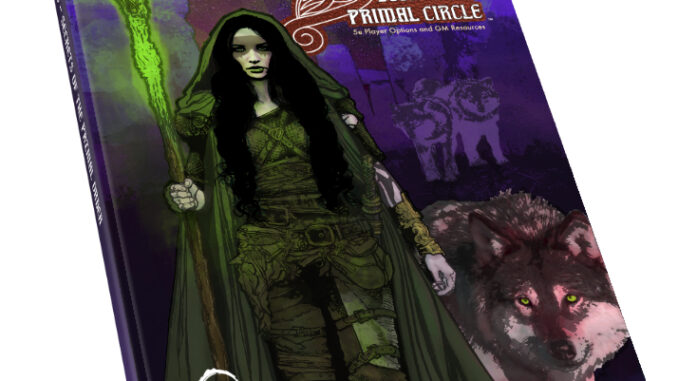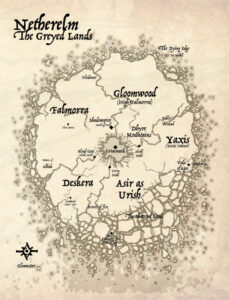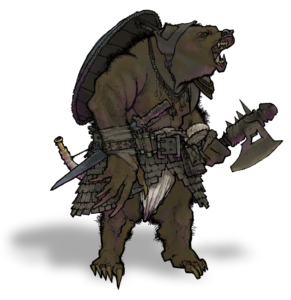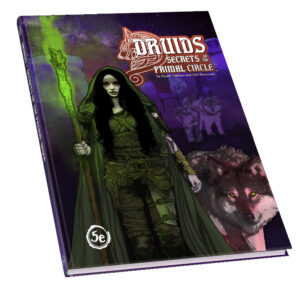
When I heard about Matthew Yarro’s plans to do a deep dive into the druid class for 5e, I was intrigued. What follows is a two-part interview with Matthew (this piece) and Shamus Williams (next interview) in which I learn all of the details about their new Kickstarter, Druids: Secrets of the Primal Circle.
EGG EMBRY (EGG): I appreciate you reaching out to me. What is Druids: Secrets of the Primal Circle?
MATTHEW YARRO (MATTHEW): Druids: Secrets of the Primal Circle is a collection of player options and GM resources that focuses entirely on the druid–It’s not just a bunch of new archetypes, spells, and magic items. We took a long look at the druid class and realized there was something missing: history and lore. Almost every other class has a lot of material to draw from that provides the class with context, purpose, and meaning. A great example is the goodly cleric. I think everyone understands they are selfless characters, and that they are aligned to a god/domain, which also helps players understand who their characters are and what their motivations are. They have temples to defend, sacred relics to recover, and a host of fiends and undead to destroy. There’s just a lot to work with for the cleric.
On the other hand, druids hug trees. I know that is a gross oversimplification, but there is a hole when it comes to a druids’ history as compared to other classes. We wanted to fill that hole with lots of great lore so that a player has a greater sense of who druids are and why they exist. For example, why do druids oppose wearing metal armor? This cornerstone feature of the druid is an enigma. No one knows why a druid opposes wearing metal armor, and it has become such a looming question with no answer in sight that people are just trying to move past it, which is a bummer because it is such a great piece of RP lore.
As part of enriching druidic lore, we included the reason for not wearing metal armor in this book. In brief, mortal druids were tricked into betraying the faerie courts by providing enchanted weapons and armor to the kingdoms of men, including humans, elves, dwarves, etc. These weapons were used to drive the fey from the lands surrounding the kingdoms–an act that devastated the fey and still has ramifications to this day. All druids are taught of this terrible blemish on their history during their initiation. In fact, reciting the story in Druidic is a rite of passage for new druids.
When druids realize the scale of the death caused by their betrayal, abstaining from wearing metal armor seems like a small penance. We’ve also introduced guidelines for those who want to make the armor restriction more than a taboo. In that case, there is a strong justification within the lore for druidic magic being disrupted when a druid wears metal armor. In a way, choosing to go that route reduces the controversy around the armor restriction, making it easy for players and GMs.
To make it even easier for players and GMs to abide by this feature, we provide several new alternative materials from which druids can fashion armor, such as Bonecraft, Ironwood, and Khorak.
In addition to these enhancements, we have created the Greyed Lands of the Netherelm, a demi-plane-like world with a history deeply tied to the origins of druids. The Netherelm has strong connections to other worlds of the Material Plane and its echoes, so it can easily be added to any campaign. And of course, the iconic villains of the Netherelm were responsible for facilitating the betrayal of the fey by druids, which continues as a feud between the creatures of the Netherelm and druids.
Along with the druids’ aversion to metal and the Netherelm, this resource blends history and lore into and around almost everything that is in this book to provide more context, direction, and meaning for players and GMs who want a deeper understanding of just who the druids are. The druid class gains purpose, players get the options they want, and GMs have a wealth of resources to use in their games. That is what makes this book so great.

EGG: Ok, so this truly is an entire book focused on Druids for 5e, that’s a win. Let’s break this down, what archetypes are you offering?
MATTHEW: We do have quite a few new archetypes in the book, but I like to think that what is really important isn’t what those archetypes are, but why we created them. The archetypes are tied to the history and lore of druids just like everything else in the book, and they help create the larger story of the druids.
There is a new variant class, the Dire Druid; 11 new archetypes, some of which are “anti-druid” archetypes bound to the Gloomstar Council of the Netherelm; and numerous enhancements or alternatives to various features, including the Druidic language, Councils, elder spirits, new elemental materials, wogging, and eldritch foraging. Everything ties back to the history of druids.
For instance, the Dire Druid is a more martial version of the druid who, long ago, traded a deeper understanding of magic and wild shaping for improved combat prowess. The dire druid doesn’t Wild Shape per se, but slowly transforms into a bestial version of a druid based upon the archetype they selected at the outset.
There is the Circle of Dread, one of the three circles of the Gloomstar Council. This circle sees nature as an opportunity to spread its influence by distorting and twisting everything it touches. A druid of this circle transforms animals into abominations and plants into monsters, believing they are improving what nature created. For example, a Circle of Dread druid might work to transform an entire herd of wild boar into skaldung – giant warped boar with tusks that curse those the creatures gore. Turning them loose in most areas would cause widespread panic.
Besides these two, there are several others including:
- Circle of Blood and Iron
- Circle of Shadow
- Circle of the Primal Guardian
- Circle of Bloodlines
- The Primal Circle
And more! All are unique interpretations of the druid archetype, and all tie back to the greater lore of the druid.
Lastly, we included druidic Councils to help shape and bring meaning to a druid’s life. Councils are geographically-aligned groups of druids who work together to manage and protect the wildlands of the world. For example, the Council that governs the enormous Greatwood Forest might be known as the Greatwood Council. Like any territorial organization, there are occasional turf wars and inter-council disturbances that can add meaning to a druid character and bring depth to a campaign.
For those who prefer the life of an unattached adventurer, there is the Wandering Council, which allows the GM to maintain continuity in a setting for both adventuring druids who want independence and those interested in belonging to a greater organization. There are also Lone Wolf druids, who have been exiled from druidic society for one infraction or another.
EGG: To many, shapeshifting is the core of the Druid class, what options are you offering to the players that just want more cool shape changing options?
MATTHEW: Oh, we have some great options. First, the Dire Druid class itself has over 10 dire shapes, the class’ equivalent of wild shaping. Everything from the more-expected wolf or bear to fun things like snakes, spiders, and insects. Then we have a lot of archetypes with wild-shaping alternatives. For example, the Circle of Bloodlines allows a druid to shift into different racial types, so a human druid could become a dwarf, elf, or half orc. The lore of that particular circle is they see humanoids as just another type of animal and want to assimilate fully into a culture in order to understand it.
There is The Primal Circle, that never learned to Wild Shape, but instead remained focused on magic. They are so in touch with magic, their bodies become ensorcelled with runes that expand their spellcasting abilities.
There is the Circle of the Primal Guardian that summons a supernatural beast from the elemental planes to serve as a loyal companion. This archetype harkens back to the older version of the druid that had an animal companion, but with more of an eldritch twist.
And finally, there is the Circle of Dread that can transform into certain Aberrations, Oozes, and Monstrosities–for good or ill. This one in particular really expands on what a druid is capable of when using Wild Shape.
EGG: What kinds of druid-specific monsters are you creating?
 MATTHEW: There are a lot of different monsters and villains to choose from. But what is really important is that we didn’t just randomly create monsters. There is a unifying theme and history tied to the creation of the Netherelm, the Shadow Court, the Gloomstar Council, and the ongoing war between these creatures and the druids. It is all linked.
MATTHEW: There are a lot of different monsters and villains to choose from. But what is really important is that we didn’t just randomly create monsters. There is a unifying theme and history tied to the creation of the Netherelm, the Shadow Court, the Gloomstar Council, and the ongoing war between these creatures and the druids. It is all linked.
So, a GM could say to the group, “While traveling, you see a Druidic mark. You immediately recognize it as the Gloomstar Mark.” That means something to a druid player who is familiar with the lore of this book. It should make the player sit up, take notice, and watch for foes around every bend. That is what we were really after – the tension that makes a great game.
EGG: It’s over 200 pages of GM resources and player options. How much of the book is for the GM versus how much is for the players?
MATTHEW: I would say 80% player options and 80% GM resource. There is a lot of overlap with the spells, magic items, eldritch items, and more. A player could just as easily leave a Druidic mark for his allies as a GM could use it to place a story hook.
EGG: With all of the possibilities in the world of D&D, what inspired you to choose druids as the subject matter for this book?
MATTHEW: Like everyone in this hobby, I like to build characters. I have created far more characters than I will ever have time to play. But I love it. I always start with an idea of the character from more of a story oriented point of view, as if he or she were the protagonist of a novel–then I figure out how to build it. I kept wanting to dabble with the druid class, but it just seemed so flat to me. I understand the fighter and cleric, the rogue and wizard, who they are and what they represent from a story standpoint. But I just didn’t have that for the druid. And when I started digging in, I found out that it really didn’t exist. To a great extent, a guy who can turn into a bear is exactly what the class is. And that was such an opportunity to spin a wealth of lore, to breathe life into an awesome class. So, I started playing around with ideas and concepts, and that just snowballed into the book.
EGG: Who is working on this project with you?
MATTHEW: Shamus Williams. This book does not happen without Shamus. Originally, it was supposed to be 50 pages–now it is well over 200. I know I would have drowned in the writing and editing if I didn’t get some help, so I am very fortunate to have partnered up with Shamus.
Also, I realized very early on that I was more of a creative force than a rules guy—and that was a problem. So when I met Shamus in a Facebook group, and realized that he was an excellent rules guy with good ideas, I immediately suggested working together on the project.
EGG: Beyond Druids: Secrets of the Primal Circle, what else are you working on?
MATTHEW: In what little spare time I have, I always try to run adventures for all the virtual conventions going on out there. It’s a great opportunity to meet people in the hobby and to sneak in some homebrew ideas. I strongly suggest it if you haven’t had the chance yet. The tools available for online play are outstanding.
Besides that, I have been wanting to finish a 5e-adaptation of Gamma World that I am calling Mutant Apocalypse; to develop an endless dungeon known as the Tower of Gax; and to spend a little more time on the free Mapper VTT. Time is the bane of gamers–that and a table of friends who can play weekly 🙂
 EGG: Thanks for talking with me. Where can fans learn more about your work?
EGG: Thanks for talking with me. Where can fans learn more about your work?
MATTHEW: I love homebrewing, so you can check us out [here].
Druids: Secrets of the Primal Circle, a 5th Edition Resource from Home Brewed Games
“200+ pages of archetypes, spells, magic items, monsters, variant rules, and more–all for the druid. A must-have for DMs and Players.”
Latest posts by Egg Embry (see all)
- New Gamemaster Month 2023 - January 20, 2023
